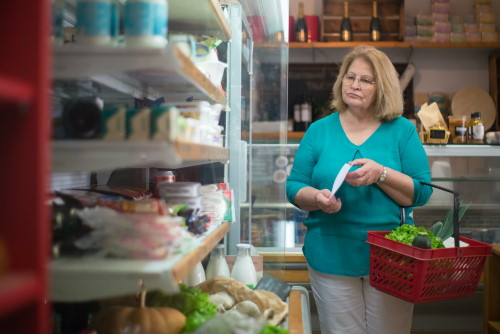Pretty much all of us have discovered, through experience, that hitting the grocery store when hungry is not a good idea. When hungry, we tend to lose self-control and end up buying foods we typically wouldn’t, often ones we know aren’t all that good for us or don’t help us reach our goals. Plus, we often go overbudget to boot. Beyond that simple and perhaps most important rule, are there other healthy grocery shopping tips worth following?
BREAKING: This Keeps Your Blood Sugar Below 100 - Even When You're Eating Sweets!
Indeed, there are! The grocery shopping tips below can help make a trip to the store faster, healthier, and less expensive. Before you get started, eat a healthy, protein- and fiber-rich meal or snack to keep you going, and drink a glass of water, so you don’t mistake thirst for hunger.
Now, let’s get to the tips…
12 Healthy Grocery Shopping Tips
1. Be Prepared
In addition to making sure your stomach isn’t grumbling before you even grab your grocery cart, planning your menu and making a list can help you stay focused and buy only what you need. Don’t forget to shop your own fridge, freezer, and pantry before you make your list to save even more on costs by eating the foods you already have.
As you’re making your list, plan not only dinners for the coming days or week but breakfasts, lunches, and snacks as well. Having healthy choices on hand for the entire day can help prevent those little indulgences that add excess calories and costs to your menu.
Don’t forget to include your family or housemates, as well, especially if you’ll be preparing food with or for some people who are a little choosier. It’s also helpful to pull out the calendar to see if there are nights when you need something superfast (to get to an event, for example), if you have planned leftovers, or if you’ll be eating away from home.
Finally, keep a running list as you run out of staples throughout the week. That way you don’t have to rely on your memory and risk forgetting a key item. Choose your preferred digital assistant, a notepad next to the fridge, or type it into your phone—just as long as you keep track. This will help save time, effort, gas, and overall costs as you reduce or eliminate one-item trips to the store because you forgot something.
Now it’s time to make your list—as you learn your grocery store, you can separate out categories depending on where you’ll find them in the store, which will help you stay streamlined and focused as you navigate. To save even more time in the future, you could also save a template on your phone or computer to use over and over again (at least until your store reorganizes or you end up at a different store).
2. Start with a Budget
One of the best ways to prevent yourself from overspending and overbuying is to start with a budget. If you know how much you have to spend, it’s easier to stick with that amount and make more affordable choices. That also means you need to keep some sort of running tally as you shop. You don’t need to be exact. It’s okay to round up or down, but this gives you a good idea of what the total amount will be when you hit the checkout counter.
3. Navigate the Aisles
Yes, this is contrary to much of the advice you hear to “shop only the outer aisles” or, at least, shop them first. However, if you know that you need brown rice, canned or bagged beans and legumes, old-fashioned or steel-cut oatmeal, or even toilet paper, you can quickly grab those first. Then pick up your other healthy items from the frozen, dairy, and quality meats sections—you can often skip some aisles altogether.
Now, it’s time to relax and slowly stroll through the produce section, enjoying all the beautiful colors of the vegetables and fruits. You can take time to look for what’s in season and what’s on sale or even just what looks tasty or appetizing as the rest of your shopping is behind you. Plus, as you load up your grocery cart with all this healthy goodness, you’re less likely to crush or bruise it.
4. Choose ALL Types of Veggies and Fruits
Especially in the off season, one of the top healthy grocery shopping tips is choosing vegetables and fruits that are frozen or even canned. Frozen and canned vegetables and fruits are often just as nutritious as their fresh counterparts and often more friendly to the budget. Plus, because these items can be stored longer, they make good choices for foods you may be making later in the week. Just make sure you check the label and avoid those with added sodium (or rinse them well before you prepare them at home) and sugar or syrups.
5. Watch Out for Additives
A lot of foods have a surprising number of additives from oil in canned fish to excess sugars (with various names) and salts added to canned vegetables. Take a moment to flip the package over to read not only the nutrition facts but the ingredients list as well.
6. Watch Out for Grains
Many products claim they contain whole grains in big bold letters on the front. But when you look more closely, they list enriched flour as the first ingredient. This is why it’s so important to look at the ingredients list. If the first ingredient isn’t an actual whole grain (and the fiber seems surprisingly lacking), put that product back and choose another product made with more wholesome ingredients.
7. Look Online for Bargains
Especially when buying nonperishable items, you may be able to save time and money by looking online first. For example, do a little scouting to see if you can get your favorite oatmeal, quinoa, high-protein snacks or powders, or nuts. Just make sure you aren’t buying foods you likely won’t eat, which can then defeat the purpose entirely and lead to greater waste.
8. Avoid Overbuying
This ties in directly to the point above. The food is only a bargain if it fits in with your healthy lifestyle and is a food you like to eat. So even if it’s reduced by 80%, if it’s going to spoil before you can’t eat it or freeze it, it will only go to waste. And, if it’s not a food that’s on your diet plan, it will only go to your waist.
If you will only eat a couple of bananas, it’s okay to split them up. Same goes for grapes. Buying the smaller bag of spinach or kale and eating every leaf still costs less than buying the big bag and letting half (or more) spoil before you’ve had a chance to consume it, even if the unit cost is a lot less.
9. Limit Prepared Foods
Sure, convenience is king, but realize that you’ll pay more for it both in terms of higher costs and, likely, higher processing. Skip the prepared food aisle altogether on most trips to the grocery store.
10. Minimize
While it’s fun to create elaborate meals with lots of ingredients from time to time, most weeks, time can get away from us. Keep your dishes simple with less ingredients. If you choose foods that are high in flavor, you can make a rich, delicious, well-rounded meal with just a handful of ingredients in minimal time.
11. Stock Up
While this is too risky for foods you’ve never tried or are just adding to your diet, once a healthy food becomes a staple, you may be able to save time and costs by buying it in bulk. Good options include beans, lentils, rice, whole-grain or bean pastas, canned tuna or chicken, raw nuts, frozen vegetables, frozen fruits, and cooking oils (e.g., olive, avocado, or coconut oils).
Keeping a few items on hand that you can throw together quickly and easily will also make healthier eating easier when life throws you a curveball.
12. Grow Your Own
One simple, though not necessarily easy, way to save on groceries is to not have to buy them. Every spring, creating even a small, minimal salad garden can supply your entire family with fresh vegetables throughout the end of spring, all summer, and into fall as long as you keep reseeding every couple of weeks. Save the seeds from past favorites to start sprouting early for even more savings over buying plants.
What Foods are Found in a Healthy Grocery Cart?
Many of us have a fairly good understanding of how to plate a healthy meal—i.e., start with a quality lean protein, such as chicken or turkey (quarter of the plate) and add a healthy carbohydrate, such as beans, sweat potatoes, or brown rice (quarter of the plate), and then finish by piling half the plate with vegetables. The same can be true of the grocery cart. Foods you’re likely to find, from highest to lowest, include:
- Fresh and frozen non-starchy vegetables like spinach, cauliflower, broccoli, asparagus, bell peppers, onions, mushrooms, avocados, etc.
- Fresh and frozen fruits like berries, citrus fruits, bananas, etc.
- Quality proteins like eggs, fish, chicken, grass-fed beef, and tofu
- Beans and legumes
- Starchy veggies like potatoes (white and sweet), squash, and carrots
- Complex carbohydrates like quinoa and brown rice
- Canned foods including canned salmon, tuna, or mackerel, beans, tomato products, etc.
- Condiments like apple cider or balsamic vinegar, olive or avocado oil, salsa, and spices
- Dairy products like Greek yogurt, extra sharp cheese, goat cheese, etc.
- Healthy fats including nuts and seeds
- Beverages like sparkling water or seltzer, teas, and coffee.
Following a healthy diet also means you can eat the foods you love. While you will want to limit food that are “less healthy,” especially those that are ultra-processed, that doesn’t mean they’re always off the list. They’re just lower on the list as you prioritize healthy whole foods.
TRENDING: 1 Cup of This Melts Belly and Arm Fat (Take Before Bed)
Healthy Grocery Shopping Tips: A Recap
Simply by planning your trip to the grocery store, making a list, and checking your fridge, freezer, and pantry before you go, you’ll find you can enjoy healthy meals and save some cash too. Plus, you’ll get in and out more quickly, which can help prevent those impulse buys that add to the budget and the waistline.
Like anything, it can take time, planning, effort, and especially practice to become a pro. But with just a few healthy grocery shopping tips, you’ll be well on your way!









